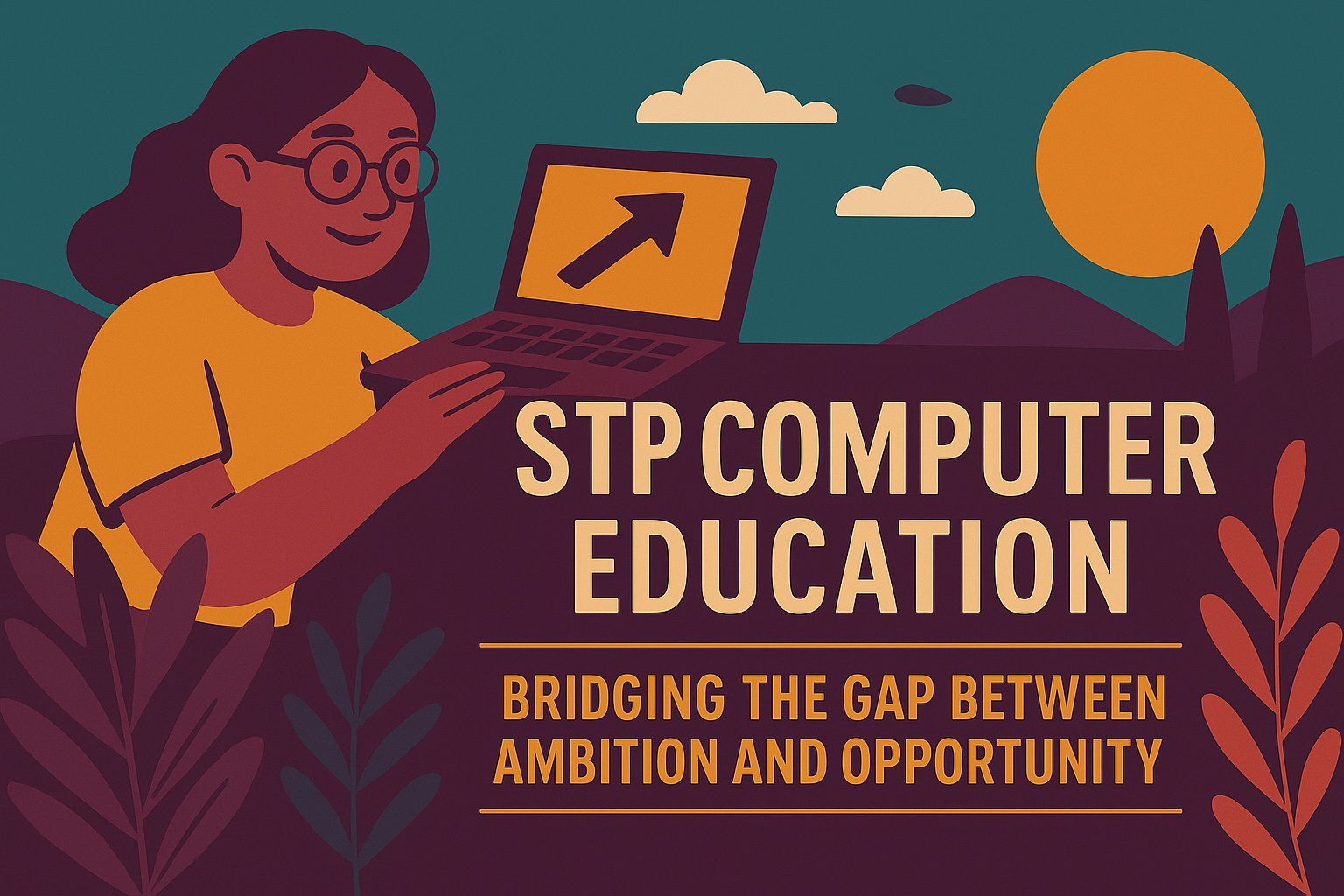Table of Contents
Why STP Computer Education Matters Today
In today’s digital economy, the value of computer literacy is no longer a luxury—it’s a necessity. Whether you’re a student, a job seeker, or a working professional, the ability to handle digital tools can make or break your career. That’s where stp computer education steps in. It’s not just about teaching students how to use a computer—it’s about transforming lives by equipping individuals with real-world skills that align with market demands.
As someone who came from a rural background with very little exposure to technology, I can personally vouch for the impact of structured computer training. I enrolled in an stp computer education course back in 2018 when I didn’t even know how to operate a mouse properly. Today, I work remotely as a UI designer and part-time blogger—and all of that started with basic digital literacy taught through this platform.
Understanding STP Computer Education: A Structured Approach
STP Computer Education is a structured, curriculum-based program aimed at imparting practical computer skills to people from all walks of life. It stands for “Systematic Training Program,” and that’s exactly what it delivers—step-by-step learning with a strong emphasis on real-world application.
What sets stp computer education apart is its modular structure. From basic courses like MS Office and Internet Basics to advanced topics like Tally ERP 9, Photoshop, and even programming languages like Python and Java, the curriculum is designed to scale with the learner’s pace and interest.
Each module ends with an assessment, which ensures that students not only learn but also retain what they’ve learned. Plus, the availability of offline and online modes makes the program highly accessible.
The Need for STP Computer Education in India
India has one of the largest youth populations in the world, but a significant portion of this demographic lacks digital literacy. According to the National Sample Survey Office (NSSO), less than 25% of Indians are digitally literate. This gap is more pronounced in rural areas.
Programs like stp computer education are filling this gap by offering affordable, practical, and job-oriented training. Institutes under this initiative are often located in Tier-2 and Tier-3 cities or even semi-urban towns, helping bridge the digital divide between urban and rural India.
For example, the STP center in Barpeta, Assam, has helped over 1,200 students get certified in just three years. Some of these students have gone on to land data entry jobs, while others started freelancing in graphic design and web development.
Course Offerings and Certification Process
The standard structure of stp computer education includes the following categories:
- Basic Courses: Computer Fundamentals, Windows OS, MS Office, Internet.
- Accounting and Finance: Tally with GST, MS Excel Advanced.
- Graphic Designing: Photoshop, CorelDRAW, Canva.
- Programming: C, C++, Python, Java.
- Web Technologies: HTML, CSS, JavaScript, WordPress.
Each course is assigned a duration (ranging from 1 to 6 months), depending on its complexity. Upon successful completion, students receive a certificate that is often recognized by small and mid-sized employers in sectors like retail, BPO, NGOs, and educational institutions.
While not equivalent to formal university degrees, stp computer education certificates hold value in freelance markets and entry-level IT jobs.
A Look into the Real Experiences of STP Students
Let’s talk about real people. Rina Das, a housewife from Siliguri, took a 3-month stp computer education course in Basic Computing and MS Excel. Today, she works as a part-time data operator for a local logistics company, earning around ₹10,000 a month.
Then there’s Ravi Kumar, who was once a school dropout from Bihar. He joined a local STP center, learned Tally with GST, and is now working as an assistant accountant in a textile store in Surat. According to Ravi, “I never thought I’d work in a place with air conditioning. STP changed my life.”
These are not extraordinary stories. They are everyday realities shaped by access to practical, affordable education.
Industry Alignment and Career Opportunities
One of the main reasons stp computer education is so effective is because it stays aligned with industry requirements. Instead of teaching theoretical concepts, it focuses on tools and workflows that are actually used in jobs.
For instance:
- In the accounting world, Tally with GST is a must-have skill.
- In the digital design space, Photoshop and CorelDRAW are the industry standard.
- For web and app development, languages like Python and Java are in high demand.
By offering these industry-aligned courses, stp computer education not only enhances employability but also allows students to explore freelancing opportunities on platforms like Upwork, Freelancer, and Fiverr.
In fact, over 40% of students from some STP centers report taking up freelance gigs or starting side hustles after their training.
Infrastructure and Teaching Methodology
One of the strong suits of stp computer education is its emphasis on practical, hands-on learning. The majority of centers under this program are equipped with modern computer labs that cater to 10–30 students at a time. Even though the hardware may not always be top-tier, it is well-maintained and sufficient for the curriculum.
Every student gets their own system during practical sessions. This is important because shared learning often dilutes the experience. With personal systems, students build muscle memory while performing tasks such as creating spreadsheets, using design tools, or writing basic code.
Most stp computer education centers also provide video tutorials and printable PDFs as supplementary learning material. Many instructors are certified or come from IT/commerce backgrounds, which ensures that the quality of training remains consistent.
Additionally, peer learning is encouraged. There are group projects in courses like Web Design and Python Programming, where students collaborate to build basic websites or applications. This boosts both confidence and teamwork skills.
Fees and Affordability
Affordability is a core reason why stp computer education has scaled across India. Course fees vary depending on the duration and complexity, but most basic certifications cost between ₹1,500 to ₹6,000 for the entire duration. This includes:
- Registration
- Course material
- Lab access
- Final certification
There are also installment payment options, especially in semi-urban and rural branches. In some cases, STP centers have tie-ups with local NGOs or government programs to offer free or subsidized training for underprivileged youth and women.
Compared to private institutes that may charge ₹25,000 or more for similar content, stp computer education makes digital skills accessible to all income groups. As a result, even someone working as a part-time delivery agent or vegetable vendor can afford to learn computing skills and aim higher.
STP Computer Education vs Other Institutes
When evaluating computer training options, people often compare stp computer education with branded institutes like NIIT, Aptech, or Arena Animation. While those brands do have global reach and sometimes offer more sophisticated tools, they come at a premium cost.
Here’s a quick comparison:
| Parameter | STP Computer Education | Private Institutes (NIIT/Aptech) |
| Average Fee per Course | ₹1,500 -₹6,000 | ₹10,000-₹50,000+ |
| Course Duration | 1 to 6 months | 3 to 12 months |
| Certificate Recognition | Local/Regional Jobs | Corporate/Global Jobs |
| Accessibility (Tier-2 & 3 cities) | High | Low to Moderate |
| Practical Hands-on Focus | Strong | Mixed |
If your primary goal is affordable, hands-on learning with local job-readiness, stp computer education serves that purpose extremely well. However, if you are aiming for an international role or tech startup exposure, you may eventually need to supplement it with advanced courses from larger institutions or online platforms.
Common Challenges Faced and Solutions Offered
Of course, no system is perfect. Like many grassroots education initiatives, stp computer education has its own set of challenges:
1. Limited Brand Recognition
Many employers are unfamiliar with STP certificates compared to branded training centers. However, this is improving as more companies hire candidates based on practical skills rather than logos on certificates.
2. Language Barriers
In rural centers, English-medium instruction is a problem. To fix this, some centers now provide training in local languages like Hindi, Assamese, Bengali, or Tamil.
3. Outdated Software
Some centers lag in updating tools. But regular audits and a growing push for digital transformation have prompted many locations to upgrade systems and license newer versions of software.
4. Inconsistent Faculty
Instructor quality can vary. To counter this, the STP network has launched train-the-trainer programs and online instructor certifications to ensure a minimum standard across centers.
Despite these hurdles, the program thrives because of its responsiveness to student feedback and community engagement.
The Future of STP Computer Education
As the world becomes more reliant on AI, data analytics, and digital platforms, stp computer education must evolve. And it’s already doing so.
Several centers are introducing:
- AI and ML Basics for senior students
- Digital Marketing modules with hands-on tools like Google Ads and Meta Ads Manager
- Freelance Readiness sessions on platforms like Fiverr and Upwork
- Cybersecurity Essentials for youth working in data-sensitive industries
There’s also talk of integrating online certification and remote learning for students in extremely remote regions. During the COVID-19 pandemic, some STP centers successfully piloted online Zoom-based instruction and Google Classroom integration.
With proper government support, collaborations with ed-tech companies, and grassroots promotion, stp computer education could become one of India’s largest and most impactful skill development platforms.
A Personal Reflection on STP Computer Education
When I first heard about stp computer education, I assumed it would be just another low-budget course with outdated material and no practical use. But after enrolling and spending six months learning MS Office, Photoshop, and a bit of web design, my opinion changed drastically.
What impressed me the most was how relevant and skill-based the entire training was. There were no long theoretical lectures—everything was taught with an example or real-world case. From formatting resumes to creating small business flyers, the course gave me a tangible skillset I still use today in my freelance work.
What surprised me further was that many of my batchmates found jobs within two months of completing their respective modules. Some went into teaching, others joined retail chains as billing executives, and a few even started YouTube channels after learning video editing basics.
It made me realize that stp computer education isn’t just about computers—it’s about unlocking possibilities for people who don’t have access to big city training centers or formal degrees.
Frequently Asked Questions (FAQs)
Q1. Is STP Computer Education recognized by employers?
Yes, especially in local job markets and freelance ecosystems. While it may not be globally recognized like Microsoft or Cisco certifications, employers in sectors like retail, education, admin support, and NGOs value the practical skillset it imparts.
Q2. How long are the courses under STP Computer Education?
Courses typically range from 1 to 6 months, depending on the subject. Basic courses like MS Office take about 1–2 months, while advanced ones like Tally with GST or Python may take 3–6 months.
Q3. Are STP courses available online?
Some centers have started offering online training through video lectures and Zoom sessions, especially after the pandemic. However, most programs are still conducted offline, focusing on lab-based practical learning.
Q4. What is the average cost of STP Computer Education courses?
The average fee ranges from ₹1,500 to ₹6,000, making it one of the most affordable skill-based training programs in India. Subsidies and installment options are often available.
Q5. Can I get a job after completing STP Computer Education?
Yes. Many students find jobs in data entry, billing, admin roles, graphic design, and even freelancing after course completion. It boosts employability significantly in Tier-2 and Tier-3 job markets.
Q6. Are there any age limits to join STP Computer Education?
There is no strict age limit. While most students are between 15–30 years old, even housewives, senior citizens, and school dropouts join to enhance their digital skills.
Q7. What kind of certificate is provided?
A completion certificate is given at the end of the course. While it’s not university-affiliated, it helps in local employment and freelance credibility.
Should You Join STP Computer Education?
If you are someone looking to build digital skills without breaking the bank, stp computer education is one of the most practical choices available in India today.
It doesn’t matter if you’re a student, job seeker, homemaker, or someone who never touched a computer before. The structured learning, affordability, and local job relevance make it a high-value investment in your future.
In a country where unemployment is high and competition fierce, practical skills are your biggest asset. And stp computer education delivers exactly that.
You don’t need a fancy college degree to learn Excel. You don’t need a tech background to create posters in Photoshop. What you need is the right platform—and this might be the one.
So if there’s an STP center near you, walk in. Ask questions. Take a demo class. You might just walk out with a roadmap to your new career.
Empowering Women and Marginalized Communities Through STP Computer Education
One of the most overlooked but impactful aspects of stp computer education is how it empowers women, minorities, and marginalized communities. In many parts of India, especially rural and semi-urban areas, women still lack access to quality education due to cultural and economic constraints. STP centers, often run at a community level, make it easier for these women to join courses close to home.
For instance, in states like Uttar Pradesh and West Bengal, STP initiatives have partnered with NGOs to specifically train female students in basic computing, Excel, and Tally, helping them become financially independent. These women are now working as assistants in local government offices, shop managers, or data entry operators.
What’s even more powerful is the ripple effect—one digitally educated woman often becomes the guiding force for her family’s education decisions. She can help her children with schoolwork, assist her spouse in digital banking or online job searches, and even teach neighbors the basics of internet usage.
This makes stp computer education more than just a training program. It becomes a grassroots movement of digital empowerment.
STP Computer Education and the Gig Economy
Another powerful outcome of stp computer education is its alignment with the booming gig economy. India is currently one of the top countries for freelance services, with over 15 million freelancers offering everything from graphic design to virtual assistance.
Courses like:
- Photoshop
- Canva and basic design tools
- WordPress website development
- Typing and transcription tools
- Digital marketing basics
are particularly valuable in helping learners earn through online platforms. Platforms like Fiverr, Freelancer, and Upwork have seen a rise in Indian profiles, many of whom started with basic digital training through programs like STP.
Consider 22-year-old Pradeep from Ranchi who, after completing a 4-month stp computer education course in WordPress and Canva, started creating small websites for local shops and earning ₹15,000–₹20,000 a month as a freelancer. His story isn’t rare anymore—it’s becoming a pattern.
Collaboration with Local Businesses and Government Bodies
In recent years, several stp computer education centers have started collaborating with local industries, municipal bodies, and government skill missions to create a supply chain of skilled labor. These collaborations help in:
- Identifying the skills in demand locally
- Offering customized batches based on job vacancies (e.g., billing, clerical work)
- Organizing campus placements for students
In some areas, STP-trained students are even being recruited for digitization projects—like scanning legal records, managing rural healthcare data, or teaching basic IT in primary schools.
This synergy between local job creation and education gives STP centers long-term relevance and ensures students don’t just get a certificate but real placement opportunities.
Future Potential: Going Beyond Just Courses
To remain relevant in an AI-dominated future, stp computer education needs to evolve. And there are visible steps being taken:
- AI & ML Awareness: STP centers in bigger towns are starting to conduct basic awareness seminars in Artificial Intelligence and Machine Learning, preparing students for future upgrades.
- Remote Learning Modules: Hybrid learning models using Google Meet and LMS (Learning Management Systems) are being tested to reach remote learners without losing quality.
- Soft Skills Integration: Courses now include English-speaking, resume writing, and interview prep to give students a holistic edge in competitive job markets.
- Entrepreneurship Training: In some pilot STP centers, students are being taught how to start freelancing, open small tech-based businesses like printing and design shops, or offer home-based data entry services.
This kind of forward-looking approach is what will keep stp computer education not just relevant, but essential for the future of skill-based employment in India.
What Makes STP Computer Education Different from Online Platforms?
With platforms like Udemy, Coursera, and YouTube offering thousands of free courses, why should someone choose stp computer education?
Here’s the reality: while online platforms are great, they require self-discipline, English proficiency, and stable internet—all of which are not readily available to many aspiring learners in rural and semi-urban India.
STP offers:
- Hands-on learning with local instructors
- Peer interaction and community support
- Affordable offline learning
- Certificates with local job value
In a country where digital infrastructure still has limitations, this human-led learning model is much more accessible, especially for first-generation learners.
Summary: STP Computer Education as a Catalyst for Change
Let’s recap what makes stp computer education such a powerful initiative:
- Affordable digital education tailored for rural and semi-urban youth
- A wide range of practical, industry-relevant courses
- Empowerment of women and underprivileged groups
- Alignment with local jobs and gig economy trends
- A strong focus on certification, confidence building, and real skills
- Emerging modules on AI, digital marketing, and entrepreneurship
Most importantly, it doesn’t require a high-end laptop or fluent English to start. It just requires willpower and access—and STP provides both.




Leave a Reply